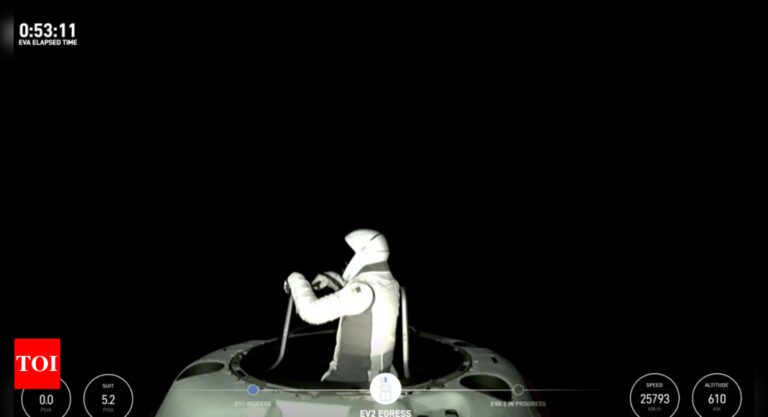
[ad_1]
MUMBAI: At about 4.20 pm (IST) on Thursday, when SpaceX’s Dragon spacecraft was zooming at a speed of 25,271 kmh over the Indian Ocean at an altitude of 740 kms, world space history crossed a major milestone when billionaire Jared Isaacman emerged from the capsule, becoming the first non-professional and private spaceman to execute a flawless spacewalk.
This was part of the Polaris Dawn mission which successfully carried out the world’s first private spacewalk.
Isaacman was exposed to the space environment for about 10 to 15 minutes, tethered and clinging to the spacecraft with one hand while carrying out manoeuvres and waving with the other. Staring at the earth below him, he remarked: “This sure looks like a perfect world.”
About 15 minutes after he returned to the spacecraft, he was followed by mission specialist Sarah Gilles, also a non-professional astronaut, who came out of Dragon when it was flying at 25,806 kmh at an altitude of 610 kms.
Like Isaacman, she carried out what is known as the “mobility evaluation of the space suit”, by waving her hands.
Both of them broke a world record as they became the first private individuals — not attached to any space organization like Nasa — to do a spacewalk which could prove to be a trendsetter.
As it was basically an experimental mission with a lot of risks, they did not float around as other astronauts do during spacewalks. Instead they held on to the spacecraft. In scientific jargon, it is still termed as a spacewalk.
As Polaris Dawn and SpaceX explained, the main role of the spacewalk was to evaluate the specially-designed SpaceX hi-tech extra vehicular activity spacesuits. This, according to them, will help in designing future space suits for moon and Mars missions.
Prior to the spacewalk, the cabin was depressurised and the process of what is known as “pre-breathe” started, which reduced the risk of decompression sickness among the crew members.
The crew lowered the cabin’s interior pressure bringing the environment closer to conditions needed for a spacewalk.
Depressurisation helped the crew to acclimatise. The Dragon does not have an airlock, which means all the four crew members were exposed to the vacuum of space once the spacecraft’s hatch was opened.
Consequently, the two others — the pilot, Scott ‘Kidd’ Poteet, and mission specialist and medical doctor Anna Menon, who did not do the spacewalk — also had to don the spacesuit when the spacewalk was in progress.
Prior to the spacewalk, after completing six orbits reaching an altitude of more than 1,400 kms, marking the farthest humans have travelled in space since the completion of the Apollo programme 50 years ago, Gilles and Menon became the first two women to have flown this far in space.
After completing six orbits of earth at this altitude, Dragon performed a series of descent burns to reach an altitude of about 700 kms for the historic spacewalk on Thursday.
This was part of the Polaris Dawn mission which successfully carried out the world’s first private spacewalk.
Isaacman was exposed to the space environment for about 10 to 15 minutes, tethered and clinging to the spacecraft with one hand while carrying out manoeuvres and waving with the other. Staring at the earth below him, he remarked: “This sure looks like a perfect world.”
About 15 minutes after he returned to the spacecraft, he was followed by mission specialist Sarah Gilles, also a non-professional astronaut, who came out of Dragon when it was flying at 25,806 kmh at an altitude of 610 kms.
Like Isaacman, she carried out what is known as the “mobility evaluation of the space suit”, by waving her hands.
Both of them broke a world record as they became the first private individuals — not attached to any space organization like Nasa — to do a spacewalk which could prove to be a trendsetter.
As it was basically an experimental mission with a lot of risks, they did not float around as other astronauts do during spacewalks. Instead they held on to the spacecraft. In scientific jargon, it is still termed as a spacewalk.
As Polaris Dawn and SpaceX explained, the main role of the spacewalk was to evaluate the specially-designed SpaceX hi-tech extra vehicular activity spacesuits. This, according to them, will help in designing future space suits for moon and Mars missions.
Prior to the spacewalk, the cabin was depressurised and the process of what is known as “pre-breathe” started, which reduced the risk of decompression sickness among the crew members.
The crew lowered the cabin’s interior pressure bringing the environment closer to conditions needed for a spacewalk.
Depressurisation helped the crew to acclimatise. The Dragon does not have an airlock, which means all the four crew members were exposed to the vacuum of space once the spacecraft’s hatch was opened.
Consequently, the two others — the pilot, Scott ‘Kidd’ Poteet, and mission specialist and medical doctor Anna Menon, who did not do the spacewalk — also had to don the spacesuit when the spacewalk was in progress.
Prior to the spacewalk, after completing six orbits reaching an altitude of more than 1,400 kms, marking the farthest humans have travelled in space since the completion of the Apollo programme 50 years ago, Gilles and Menon became the first two women to have flown this far in space.
After completing six orbits of earth at this altitude, Dragon performed a series of descent burns to reach an altitude of about 700 kms for the historic spacewalk on Thursday.
[ad_2]

Your blog has quickly become one of my favorites. Your writing is both insightful and thought-provoking, and I always come away from your posts feeling inspired. Keep up the phenomenal work!
Comments are closed.